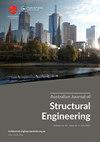Development of Prediction Models for Shear Strength of FRP Reinforced Fibrous Concrete Beams without Stirrups Using ANN and Nonlinear Regression
IF 1.3
Q4 ENGINEERING, CIVIL
Australian Journal of Structural Engineering
Pub Date : 2023-09-10
DOI:10.1080/13287982.2023.2254035
引用次数: 0
Abstract
The shear behaviour of fibre-reinforced polymer reinforced concrete (FRP-RC) beams without web reinforcement suffers from low strength, low stiffness, more brittleness and wide and quick propagated cracks. Fortunately, the addition of various types of fibres could improve most of these weaknesses. On the other hand, the shear strength prediction of FRP-RC beams with various types of fibres is one of the most complex cases in structural engineering applications. Developing generalised, precise and consistent prediction models are necessary and very limited. This paper investigates the impacts of various types of fibres on shear strength and presents proposing four new prediction models, utilising artificial neural networks and empirical nonlinear regression analysis, and modifying the combination of available models based on a collected database of 49 shear test results of FRP-RC members with various types of fibres. The comparison of the developed models with the available equations from the literature indicates that the developed models yielded excellent performance, great efficiency and a high level of accuracy over all other existing models. Additionally, the parametric study confirmed that all the developed models have great abilities to accurately predict the actual response of each parameter, in spite of its complexity, on the shear strength of FRP-reinforced fibrous concrete beams without stirrups.基于神经网络和非线性回归的无箍筋FRP筋纤维混凝土梁抗剪强度预测模型的建立
纤维增强聚合物混凝土(FRP-RC)无腹板加固梁的抗剪性能低、刚度低、脆性大、裂缝宽且扩展快。幸运的是,添加各种类型的纤维可以改善大多数这些弱点。另一方面,不同类型纤维的FRP-RC梁的抗剪强度预测是结构工程应用中最复杂的情况之一。发展一般化的、精确的和一致的预测模型是必要的,也是非常有限的。本文研究了不同类型纤维对抗剪强度的影响,利用人工神经网络和经验非线性回归分析提出了四种新的预测模型,并根据收集的49种不同类型纤维的FRP-RC构件的抗剪试验结果对现有模型的组合进行了修改。将所建立的模型与文献中已有的方程进行了比较,结果表明所建立的模型与现有的所有模型相比,具有优异的性能、较高的效率和较高的精度。此外,参数化研究证实了所建立的模型能够准确地预测各个参数对无箍筋frp纤维混凝土梁抗剪强度的实际响应,尽管这些参数很复杂。
本文章由计算机程序翻译,如有差异,请以英文原文为准。
求助全文
约1分钟内获得全文
求助全文
来源期刊

Australian Journal of Structural Engineering
ENGINEERING, CIVIL-
CiteScore
2.50
自引率
0.00%
发文量
31
期刊介绍:
The Australian Journal of Structural Engineering (AJSE) is published under the auspices of the Structural College Board of Engineers Australia. It fulfils part of the Board''s mission for Continuing Professional Development. The journal also offers a means for exchange and interaction of scientific and professional issues and technical developments. The journal is open to members and non-members of Engineers Australia. Original papers on research and development (Technical Papers) and professional matters and achievements (Professional Papers) in all areas relevant to the science, art and practice of structural engineering are considered for possible publication. All papers and technical notes are peer-reviewed. The fundamental criterion for acceptance for publication is the intellectual and professional value of the contribution. Occasionally, papers previously published in essentially the same form elsewhere may be considered for publication. In this case acknowledgement to prior publication must be included in a footnote on page one of the manuscript. These papers are peer-reviewed as new submissions. The length of acceptable contributions typically should not exceed 4,000 to 5,000 word equivalents. Longer manuscripts may be considered at the discretion of the Editor. Technical Notes typically should not exceed about 1,000 word equivalents. Discussions on a Paper or Note published in the AJSE are welcomed. Discussions must address significant matters related to the content of a Paper or Technical Note and may include supplementary and critical comments and questions regarding content.
 求助内容:
求助内容: 应助结果提醒方式:
应助结果提醒方式:


